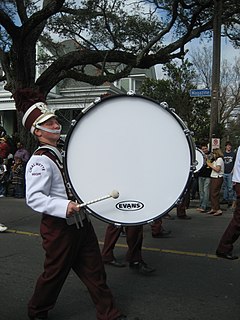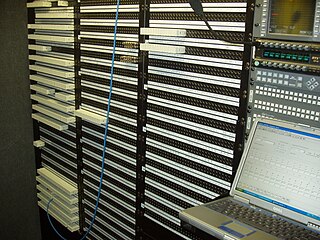An audio router is a device that transports audio signals from inputs to outputs.

In physics, sound is a vibration that typically propagates as an audible wave of pressure, through a transmission medium such as a gas, liquid or solid.
An audio router is a device that transports audio signals from inputs to outputs.

In physics, sound is a vibration that typically propagates as an audible wave of pressure, through a transmission medium such as a gas, liquid or solid.
The number of inputs and outputs varies dramatically. The way routers are described is normally number of inputs by number of outputs e.g. 2x1, 256x256.
The type of signals transported - switched can be analogue - Analog - audio signals or Digital. Digital audio usually is in the AES/EBU standard for broadcast use. Broadband routers can route more than one signal type e.g. analogue or more than one type of digital.
An analog signal is any continuous signal for which the time-varying feature (variable) of the signal is a representation of some other time varying quantity, i.e., analogous to another time varying signal. For example, in an analog audio signal, the instantaneous voltage of the signal varies continuously with the pressure of the sound waves. It differs from a digital signal, in which the continuous quantity is a representation of a sequence of discrete values which can only take on one of a finite number of values. The term analog signal usually refers to electrical signals; however, mechanical, pneumatic, hydraulic, human speech, and other systems may also convey or be considered analog signals.
Digital data, in information theory and information systems, is the discrete, discontinuous representation of information or works. Numbers and letters are commonly used representations.

Digital audio is sound that has been recorded in, or converted into, digital form. In digital audio, the sound wave of the audio signal is encoded as numerical samples in continuous sequence. For example, in CD audio, samples are taken 44100 times per second each with 16 bit sample depth. Digital audio is also the name for the entire technology of sound recording and reproduction using audio signals that have been encoded in digital form. Following significant advances in digital audio technology during the 1970s, it gradually replaced analog audio technology in many areas of audio engineering and telecommunications in the 1990s and 2000s.
Because any of the inputs can be routed to any output, the internal arrangement of the router is arranged as a number of crosspoints which can be activated to pass the corresponding signal to the desired output.
Imagine Communications is an Irish internet service provider and telecommunications operator, who provide WiMAX, wireless broadband and resell Eircom telecommunications wholesale packages. The company operates in Ireland, the United Kingdom, the Netherlands, Austria, Norway and the United States.

FOR-A is a brand name for professional broadcast video and audio equipment. Founded more than 41 years ago and based in Japan, FOR-A has spread globally, with subsidiaries in America, Canada, Korea, Italy, and the United Kingdom.
Klotz Digital AG was a manufacturer of audio media products based in Munich, Germany. The company was active in the two business segments Public Address and Radio & TV Broadcast. Its products include systems for radio broadcast, television broadcast, live sound, public address, and commercial sound.
| This technology-related article is a stub. You can help Wikipedia by expanding it. |

An amplifier, electronic amplifier or (informally) amp is an electronic device that can increase the power of a signal. It is a two-port electronic circuit that uses electric power from a power supply to increase the amplitude of a signal applied to its input terminals, producing a proportionally greater amplitude signal at its output. The amount of amplification provided by an amplifier is measured by its gain: the ratio of output voltage, current, or power to input. An amplifier is a circuit that has a power gain greater than one.

In electronics, a multiplexer is a device that combines several analog or digital input signals and forwards them into a single output line. A multiplexer of inputs has select lines, which are used to select which input line to send to the output. Multiplexers are mainly used to increase the amount of data that can be sent over the network within a certain amount of time and bandwidth. A multiplexer is also called a data selector. Multiplexers can also be used to implement Boolean functions of multiple variables.

In electronics, an analog-to-digital converter is a system that converts an analog signal, such as a sound picked up by a microphone or light entering a digital camera, into a digital signal. An ADC may also provide an isolated measurement such as an electronic device that converts an input analog voltage or current to a digital number representing the magnitude of the voltage or current. Typically the digital output is a two's complement binary number that is proportional to the input, but there are other possibilities.

In telecommunications and computer networks, multiplexing is a method by which multiple analog or digital signals are combined into one signal over a shared medium. The aim is to share a scarce resource. For example, in telecommunications, several telephone calls may be carried using one wire. Multiplexing originated in telegraphy in the 1870s, and is now widely applied in communications. In telephony, George Owen Squier is credited with the development of telephone carrier multiplexing in 1910.

Time-division multiplexing (TDM) is a method of transmitting and receiving independent signals over a common signal path by means of synchronized switches at each end of the transmission line so that each signal appears on the line only a fraction of time in an alternating pattern. It is used when the bit rate of the transmission medium exceeds that of the signal to be transmitted. This form of signal multiplexing was developed in telecommunications for telegraphy systems in the late 19th century, but found its most common application in digital telephony in the second half of the 20th century.

SCART is a French-originated standard and associated 21-pin connector for connecting audio-visual (AV) equipment.

In electronics, a digital-to-analog converter is a system that converts a digital signal into an analog signal. An analog-to-digital converter (ADC) performs the reverse function.

A DVD player is a device that plays DVD discs produced under both the DVD-Video and DVD-Audio technical standards, two different and incompatible standards. Some DVD players will also play audio CDs. DVD players are connected to a television to watch the DVD content, which could be a movie, a recorded TV show, or other content.

The modular synthesizer is a type of synthesizer, which exists in both physical and virtual forms, consisting of separate specialized modules. The specialization is usually in the module being designed to allow the modification or processing of one parameter of a signal, such as the frequency (oscillator), spectrum (filter), or amplitude (amplifier). The modules are not hardwired together but are connected together with patch cords, a matrix patching system, or switches to create a patch. The voltages from the modules may function as (audio) signals, control voltages, or logic conditions.

In sound recording and reproduction, and sound reinforcement systems, a mixing console is an electronic device for combining sounds of many different audio signals. Inputs to the console include microphones being used by singers and for picking up acoustic instruments, signals from electric or electronic instruments, or recorded music. Depending on the type, a mixer is able to control analog or digital signals. The modified signals are summed to produce the combined output signals, which can then be broadcast, amplified through a sound reinforcement system or recorded.

Component video is a video signal that has been split into two or more component channels. In popular use, it refers to a type of component analog video (CAV) information that is transmitted or stored as three separate signals. Component video can be contrasted with composite video in which all the video information is combined into a single line level signal that is used in analog television. Like composite, component-video cables do not carry audio and are often paired with audio cables.
Frequency response is the quantitative measure of the output spectrum of a system or device in response to a stimulus, and is used to characterize the dynamics of the system. It is a measure of magnitude and phase of the output as a function of frequency, in comparison to the input. In simplest terms, if a sine wave is injected into a system at a given frequency, a linear system will respond at that same frequency with a certain magnitude and a certain phase angle relative to the input. Also for a linear system, doubling the amplitude of the input will double the amplitude of the output. In addition, if the system is time-invariant, then the frequency response also will not vary with time. Thus for LTI systems, the frequency response can be seen as applying the system's transfer function to a purely imaginary number argument representing the frequency of the sinusoidal excitation.
An encoder is a device, circuit, transducer, software program, algorithm or person that converts information from one format or code to another, for the purpose of standardization, speed or compression.

A vision mixer is a device used to select between several different video sources and, in some cases, compositing video sources together to create special effects. This is similar to what a mixing console does for audio.
Delta-sigma modulation is a method for encoding analog signals into digital signals as found in an analog-to-digital converter (ADC). It is also used to convert high bit-count, low-frequency digital signals into lower bit-count, higher-frequency digital signals as part of the process to convert digital signals into analog as part of a digital-to-analog converter (DAC).
A television transmitter is a transmitter that is used for terrestrial (over-the-air) television broadcasting. It is an electronic device that radiates radio waves that carry a video signal representing moving images, along with a synchronized audio channel, which is received by television receivers belonging to a public audience, which display the image on a screen. A television transmitter, together with the broadcast studio which originates the content, is called a television station. Television transmitters must be licensed by governments, and are restricted to a certain frequency channel and power level. They transmit on frequency channels in the VHF and UHF bands.

A patch panel, patch bay, patch field or jack field is a device or unit featuring a number of jacks, usually of the same or similar type, for the use of connecting and routing circuits for monitoring, interconnecting, and testing circuits in a convenient, flexible manner. Patch panels are commonly used in computer networking, recording studios, radio and television.
An audio/video receiver (AVR) is a consumer electronics component used in a home theater. Its purpose is to receive audio and video signals from a number of sources, and to process them to drive loudspeakers and displays such as a television, monitor or video projector. Inputs may come from a satellite receiver, radio, DVD players, Blu-ray Disc players, VCRs or video game consoles. The AVR source selection and settings such as volume, are typically set by a remote controller.

A video router, also known as a video matrix switch or SDI router, is an electronic switch designed to route video signals from multiple input sources such as cameras, VT/DDR, computers and DVD players, to one or more display devices, such as monitors, projectors, and TVs.
Broadcast-safe video is a term used in the broadcast industry to define video and audio compliant with the technical or regulatory broadcast requirements of the target area or region the feed might be broadcasting to. In the United States, the Federal Communications Commission (FCC) is the regulatory authority; in most of Europe, standards are set by the European Broadcasting Union (EBU).